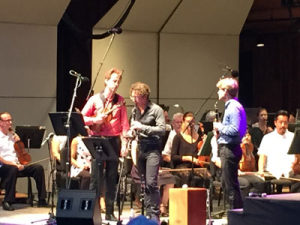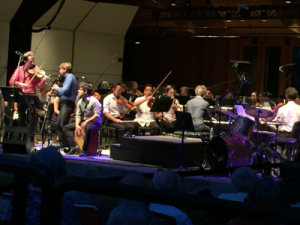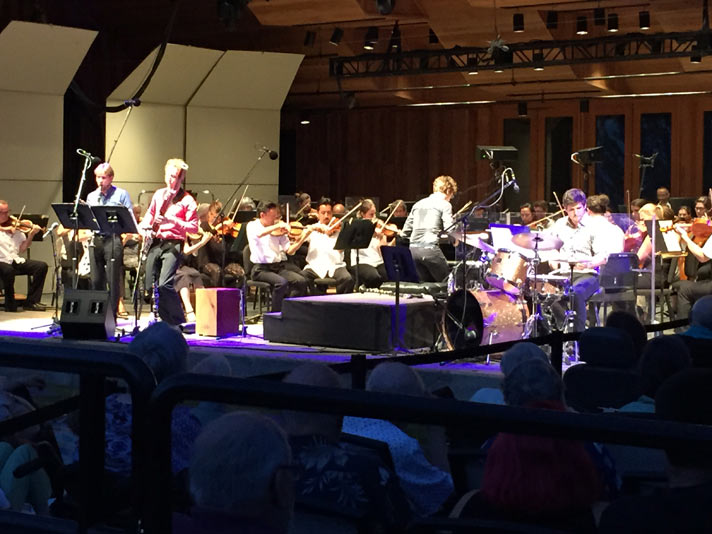The Britt Festivals presented the fourth concert of the 2015 Classical Season on Saturday evening, August 8, and it continued the pattern set the previous night. The program diverged from the staid classical programming of past Britt Classical seasons. Instead the program introduced new music, fresh collaborations with talented young artists, and revitalized takes on a couple of works from the established classical repertoire. The concert also displayed an obvious uptick in the level of energy and enthusiasm over previous seasons, catalyzed by sophomore music director Teddy Abrams but permeating throughout the orchestra and the musicians on stage.
To open the program, the orchestra performed Samuel Barber’s single movement, 10 minute long, 1942 work, Second Essay for Orchestra. Barber is one of the most celebrated composers of the 20th century.
1 min. excerpt of the Britt Orchestra, under the direction of Teddy Abrams, performing Samuel Barber’s “Second Essay for Orchestra” on August 8, 2015 in Jacksonville, OR

Guest artists bassoonist Harrison Hollingsworth, clarinetist Johnny Teyssier, and drummer Gabriel Globus-Hoenich with Teddy Abrams on piano (collectively, Sixth Floor Trio) at the front of the stage, as the Britt Orchestra, directed by Mr. Abrams, accompanies in the performance of Mr. Abrams original composition, Rock, on August 8, 2015 in Jacksonville, OR
Next, as on the previous night’s program, Mr. Abrams brought to the stage some fresh but virtuosic collaborators. On Saturday night, it was a trio of them: bassoonist/violinist Harrison Hollingsworth, clarinetist Johnny Teyssier and percussionist Gabriel Globus-Hoenich. All three of them, like Mr. Abrams, are 2008 graduates of the Curtis Institute of Music. Including Mr. Abrams, on piano and clarinet, they have widely performed, “in concert halls”, “grunge bars” and “experimental spaces” throughout the United States as the Sixth Floor Trio. [2015 Britt Classical Festival Program notes, p. 31] The Trio (all four of them – “Well, we’re graduates of a music school, so math isn’t our forte”) performed 5 pieces, with the orchestra accompanying, covering a wide range of musical genres. They began with an original composition by Mr. Abrams, aptly called Rock, with Mr. Abrams playing piano as well as directing the orchestra, and Mr. Hollingsworth on bassoon, Mr. Teyssier on clarinet and Mr. Globus-Hoenich on drums. The piece, of course in the rock genre, featured some very fine bassoon and clarinet solos.
The Trio (minus percussionist Globus-Hoenich) followed that with a couple of klezmer pieces, which were, as klezmer tends to be, in much more of a jazz genre, but with klezmer characteristic expressive melodies. For the klezmer pieces, Mr. Hollingsworth traded in his bassoon for a violin. On the first of the two klezmer pieces, the multi-talented Mr. Abrams left the piano to pick up and play a clarinet. For the second klezmer piece he was back at the piano and Mr. Teyssier handled the clarinet.

Guest artist violinist Harrison Hollingsworth and Britt Music Director/clarinetist Teddy Abrams perform a klezmer piece with the Britt Orchestra, while guest clarinetist Johnny Teyssier watches on August 8, 2015 in Jacksonville, OR.
Following the klezmer pieces, Mr. Globus-Hoenich returned to the stage, not to the drum kit, but instead seated on a Cajon box drum. With Mr. Hollingsworth on violin, Mr. Abrams on piano, Mr. Teyssier on clarinet, Mr. Globus-Hoenich on the Cajon, and the orchestra accompanying, the Trio foursome performed a piece in the bluegrass genre, Paul Shelasky’s fiddle tune, Cazadero. It was a lively number as fiddle tunes tend to be.

Guest artists violinist Harrison Hollingsworth, clarinetist Johnny Teyssier, percussionist Gabriel Globus-Hoenich, and Britt Music Director/pianist Teddy Abrams (collectively, Sixth Floor Trio) join the Britt Orchestra in performing the bluegrass fiddle tune, Cazadero on August 8, 2015 in Jacksonville, OR.
The audience responded warmly but reservedly to all four of those initial pieces featuring the Sixth Floor Trio, each of which was a far cry from the traditional classical repertoire that classical audiences are accustomed and expect to hear in a classical concert. The final piece was a different story altogether. For the final number with the Sixth Floor Trio joining, the orchestra performed the Louis Prima masterpiece made famous by George Gershwin: Sing, Sing, Sing. This piece, of course, is a long accepted part of the classical orchestra repertoire, which no doubt helped with the audience. But that doesn’t really tell the story. I don’t want to overstate the case, and I try to avoid exaggeration, but I have to tell you this was one of the absolute best performances of Sing, Sing, Sing I have EVER heard. I must confess that the piece has been a favorite of mine since childhood. I own at least half a dozen different recordings of it, including the seminal 1938 Benny Goodman recording. If there is ANY piece of music in the classical repertoire that I know well, and can offer a discerning opinion regarding a performance of, it’s Sing, Sing, Sing. With Mr. Abrams ably handling the piano part, Mr. Hollingsworth on bassoon, Mr. Teyssier on clarinet, and notably Mr. Globus-Hoenich behind the drum kit, this performance truly was sensational. (See photo at top of page.) Mr. Globus-Hoenich performed an exquisite drum solo far superior to anything I have ever heard in any other performance of the piece – live or on recording. At one juncture his solo turn included an incredible interactive exchange with the audience – back and forth between his playing and his cueing the audience response. At another point, Mr. Hollingsworth and Mr. Teyssier set down their instruments and picked up outsized cow bells to add to the percussion and really punch things up. The audience went crazy (I went crazy!) with unbridled enthusiasm, excitement and appreciation during this piece. And the ovation afterward was thunderous, sustained, wild – no question about it, the audience loved the performance of that piece and the Sixth Floor Trio had won them over.
But the concert was only at the halfway point. After an intermission, Mr. Abrams and the orchestra returned to the stage to perform the 49 minute long, 5 movement, Hector Berlioz gem, Symphonie Fantastique. Symphonie Fantastique is unique in the classical repertoire. It’s autobiographical: Berlioz was inspired to compose Symphonie Fantastique by his fantasized and ultimately failed amorous carnal obsession with the Irish actress, Harriet Smithson. The music reflects not the reality of the events that inspired Berlioz to compose the piece, but his emotional responses to the events. The symphony is hallucinatory and dream-like, leading the great Leonard Bernstein to describe it “as the first musical expedition into psychedelia”. [Wikipedia, Symphonie fantastique, https://en.wikipedia.org/wiki/Symphonie_fantastique] History suggests Berlioz composed at least a portion of it under the influence of opium. [Id.] Discussing Symphonie Fantastique in one of his Young People’s Concerts, Bernstein explains: “Berlioz tells it like it is. You take a trip, you wind up screaming at your own funeral.” [Young People’s Concert: Berlioz Takes a Trip, Leonard Bernstein, http://www.leonardbernstein.com/ypc_script_berlioz_takes_a_trip.htm]
The work IS an amazing, remarkable, magnificent musical trip. And that’s likely true of almost any performance of this extraordinary composition. But take some of the finest orchestra musicians from this country and around the world, and put them on stage with an energized and precocious Teddy Abrams, channeling the spirit of his mentor’s mentor, Leonard Bernstein, as he directs this incomparable orchestra, and you’ve got lightning in a bottle. The entire orchestra was at the top of their game. Each of the sections were energized and delivered extraordinary performances. There were so many fine solos; it’s prohibitive to try to acknowledge them all here. Just to mention a few, there was an unusually beautiful harp passage at the opening of the second movement – kudos to principal harpist Julia Coronelli. The third movement began with an equally beautiful sequence of English Horn (that would be Jason Lichtenwalter), followed by oboe (Joseph Salvalaggio). If you missed this performance, and are reduced to merely reading about it here, I feel sorry for you. Because this performance of Symphonie Fantastique was something to write home about. I’ll give you a two minute sample (from the fourth movement) of the 49 minute piece. It’s a terrible tease, not enough. You HAD to be there.
There are two remaining concerts in the 2015 Britt Classical Season, this coming weekend, on Friday, August 14 and Saturday, August 15. I’m now spoiled. Every ONE of the concerts so far in the 2015 Britt Classical Season has been outstanding: world class orchestral music; some of the most compelling pieces in the classical repertoire combined with some fresh new original orchestral music, all played superbly. I’d be stunned if the final two concerts didn’t deliver the goods equaling the outstanding quality of those already concluded. It wouldn’t surprise me if they somehow found a way to even surpass what’s already been done so far this season. Next up, Friday’s concert features guest soloist, violinist James Ehnes performing Barber’s Violin Concerto, and the orchestra performing contemporary composer Mason Bates’ 2010 composition, Mothership, and Brahms 1877 masterpiece, Symphony No. 2. You can get tickets to the remaining 2015 Britt Classical concerts online at brittfest.org or by calling the box office at 541-773-6077 or 1-800-882-7488.
Featured image caption: Guest artists clarinetist Johnny Teyssier, bassoonist Harrison Hollingsworth, and drummer Gabriel Globus-Hoenich with Teddy Abrams on piano (collectively, Sixth Floor Trio) at the front of the stage, as the Britt Orchestra, directed by Mr. Abrams, accompanies in the performance of Louis Prima’s Sing, Sing, Sing, on August 8, 2015 in Jacksonville, OR.

 Lee Greene was born & raised in a NJ family where the only religion worshipped was classical music, Leonard Bernstein was God, and the radio was constantly on and tuned to classical station WQXR (which is now always on in his Jacksonville home thanks to the miracle of the Internet). Growing up in the New York City metropolitan area and later while residing and practicing law in NYC, Lee attended oodles of Broadway and off-Broadway theater productions, as well as concerts and opera at Lincoln Center, Carnegie Hall and other NYC venues. Lee is now a retired attorney, runs a computer support business, and has served on the boards of Rogue Opera & Siskiyou Violins. Lee also writes Performing Arts reviews published on the website,
Lee Greene was born & raised in a NJ family where the only religion worshipped was classical music, Leonard Bernstein was God, and the radio was constantly on and tuned to classical station WQXR (which is now always on in his Jacksonville home thanks to the miracle of the Internet). Growing up in the New York City metropolitan area and later while residing and practicing law in NYC, Lee attended oodles of Broadway and off-Broadway theater productions, as well as concerts and opera at Lincoln Center, Carnegie Hall and other NYC venues. Lee is now a retired attorney, runs a computer support business, and has served on the boards of Rogue Opera & Siskiyou Violins. Lee also writes Performing Arts reviews published on the website,